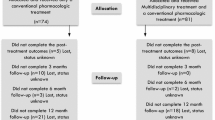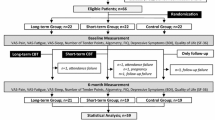Abstract
The aim of this study is to find out the outcome of 28 patients who got the diagnosis of primary fibromyalgia (pFM) 26 years ago. In 1986, 56 patients with widespread pain were examined and filled in a base questionnaire (BQ). Of them, 42 fulfilled the Yunus criteria for pFM. Twenty-six years later, addresses of 38 patients were found, and an extensive follow-up questionnaire (FupQ) was mailed to them. Of them, 28 (74%) answered the FupQ. This included nine identical questions with the BQ and questions concerning changes in their symptoms and quality of life (Qol). Three patients (11%) had healed from fibromyalgia (FM), and 23% reported having one or several symptomless periods lasting at least 1 year. In others (n = 25), all but pain and ache showed slight deterioration. Despite the aging and FM, the level of functional ability evaluated by Stanford Health Assessment Questionnaire (HAQ) remained at the same level (BQ 0.41 vs. Fup 0.44, p = 0.82). The sum score of reported symptoms (n = 21) did not change significantly (10.8 (SD 2.9) vs. 11.1 (SD 4.1), p = 0.75). Experienced sleeplessness increased most significantly (27 vs. 65%, p = 0.0034). Exercising did not have a significant influence on the changes of the measured parameters. However, the three healed patients exercised regularly. Symptoms of FM have persisted in most patients for decades without significant deterioration of self-reported functional ability. About one fourth of patients had experienced long symptomless periods during their illness. Three patients (11%) reported that they have healed from FM.


Similar content being viewed by others
References
Yunus MB (2015) Editorial review: an update on central sensitivity syndromes and the issues of nosology and psychobiology. Curr Rheumatol Ref 11(2):70–85. https://doi.org/10.2174/157339711102150702112236
Boomershine CS (2015) Fibromyalgia: the prototypical central sensitivity syndrome. Curr Rheumatol Rev 11(2):131–145. https://doi.org/10.2174/1573397111666150619095007
Bengtsson A, Bäckman E, Lindblom B, Skogh T (1994) Long term follow-up of fibromyalgia patients: clinical symptoms, muscular function, laboratory tests – an eight year comparison study. J Musculoskeletal Pain 2(2):67–80
Kennedy M, Fleson DT (1996) A prospective long-term study of fibromyalgia syndrome. Arthritis Rheum 39(4):682–685. https://doi.org/10.1002/art.1780390422
Wolfe F, Anderson J, Harkness D, Bennett RM, Caro XJ, Goldenberg DL, Russell IJ, Yunus MB (1997) Health status and disease severity in fibromyalgia: results of a six-center longitudinal study. Arthritis Rheum 40(9):1571–1579. https://doi.org/10.1002/art.1780400905
Mengshoel AM, Haugen M (2001) Health status in fibromyalgia—a followup study. Rheumatol 28:2085–2089
Baumgartner E, Finckh A, Cedrashi C, Visher TL (2002) A six year prospective study of a cohort of patients with fibromyalgia. Ann Rheum Dis 61(7):644–645. https://doi.org/10.1136/ard.61.7.644
White DH, Faull K, Jones PB (2009) An exploratory study of long-term health outcomes following an in-patient multidisciplinary program for people with fibromyalgia syndrome. Int J Rheum Dis 12(1):52–56. https://doi.org/10.1111/j.1756-185X.2009.01380.x
Walitt B, Fitzcharles MA, Hassett AL, Katz RS, Häuser W, Wolfe F (2011) The longitudinal outcome of fibromyalgia: a study of 1555 patients. J Rheumatol 38(10):2238–2246. https://doi.org/10.3899/jrheum.110026
Kashikar-Zuck S et al (2014) Long term outcomes of adolescents with juvenile-onset fibromyalgia in early adulthood. Pediatrics 133(3):592–600
Markkula R, Kalso E, Huunan-Seppälä A, Koskenvuo M, Koskenvuo K, Leino-Arjas P, Kaprio J (2011) The burden of symptoms predicts early retirement: a twin cohort study on fibromyalgia-associated symptoms. Eur J Pain 15(7):741–747. https://doi.org/10.1016/j.ejpain.2011.01.004
Wolfe F, Hasset AL, Wallit B, Michaud K (2011) Mortality in fibromyalgia: a study of 8,186 patients over thirty-five years. Arthritis Care Res (Hoboken) 63(1):95–101
Yunus MF, Masi AT, Calabro JJ, Miller KA, Feigenbaum SL (1981) Primary fibromyalgia (fibrositis). Clinical study of 50 patients with matched normal controls. Semin Arthritis Rheum 11(1):151–171. https://doi.org/10.1016/0049-0172(81)90096-2
Fries JF, Spitz PW, Kraines RG (1980) Measurement of patient outcome in arthritis. Arthritis Rheum 23(2):137–145. https://doi.org/10.1002/art.1780230202
Keltikangas-Järvinen L, Rimon R (1987) Rimon’s brief depression scale, a rapid method for screening depression. Psychol Rep 60(1):111–119. https://doi.org/10.2466/pr0.1987.60.1.111
Gauffin J, Hankama T, Kautiainen H, Arkela-Kautiainen M, Hannonen P, Haanpää M (2012) Validation of a Finnish version of the Fibromyalgia Impact Questionnaire (Finn- FIQ). Scand J Pain 3:15–20
Vainiola T, Pettilä V, Roine RP, Räsänen P, Rissanen AM, Sintonen H (2010) Comparison of two utility instruments, the EQ-5D and the 15D, in the critical care setting. Intensive Care Med 36(12):2090–2093. https://doi.org/10.1007/s00134-010-1979-1
Wolfe F, Smythe HA, Yunus MB, Bennett RM, Bombardier C, Goldenberg DL, Tugwell P, Campbell SM, Abeles M, Clark P, Fam AG, Farber SJ, Fiechtner JJ, Michael Franklin C, Gatter RA, Hamaty D, Lessard J, Lichtbroun AS, Masi AT, Mccain GA, John Reynolds W, Romano TJ, Jon Russell I, Sheon RP (1990) The American College of Rheumatology 1990 criteria for the classification of fibromyalgia. Report of the Multicenter Criteria Committee. Arthritis Rheum 33(2):160–172. https://doi.org/10.1002/art.1780330203
Granges G, Zilko P, Littlejohn GO (1994) Fibromyalgia syndrome: assessment of the severity of the condition 2 years after diagnosis. J Rheumatol 21(3):523–529
Henriksson CM (1994) Longterm effects of fibromyalgia on everyday life. A study of 56 patients. Scand J Rheumatol 23(1):36–41. https://doi.org/10.3109/03009749409102133
Fitzcharles MA, Costa DD, Pöyhiä R (2003) A study of standard care in fibromyalgia syndrome: a favorable outcome. J Rheumatol 30(1):154–159
Viola-Saltzman M, Watson NF, Bogart A, Goldberg J, Buchwald D (2010) High prevalence on restless legs syndrome among patients with fibromyalgia: a controlled cross-sectional study. J Clin Sleep Med 15:423–427
Bjorvatn B, Leissner L, Ulfberg J et al (2005) Prevalence, severity and risk factors of restless legs syndrome in the general adult population in two Scandinavian countries. Sleep Med 6(4):307–312. https://doi.org/10.1016/j.sleep.2005.03.008
Guedji D, Weinberger A (1990) Effect of weather conditions on rheumatic patients. Ann Rheum Dis 49(3):158–159. https://doi.org/10.1136/ard.49.3.158
Miranda LS et al (2007) Perceived pain and weather changes in rheumatic patients. Acta Reumatol Port 32(4):351–361
Smedslund G, Eide H, Kristjansdottir OB, Nes AA, Sexton H, Fors EA (2014) Do weather changes influence pain levels in women with fibromyalgia, and can psychosocial variables moderate these influences? Int J Biometeorol 58(7):1451–1457. https://doi.org/10.1007/s00484-013-0747-7
Fors EA, Sexton H (2002) Weather and the pain in fibromyalgia: are they related? Ann Rheum Dis 61(3):247–250. https://doi.org/10.1136/ard.61.3.247
Isomäki H (1988) The sauna and rheumatic diseases. Ann Clin Res 20(4):271–275
Hasset AL, Clauw D (2010) The role of stress in rheumatic diseases. Arthritis Res Ther 12(3):123. https://doi.org/10.1186/ar3024
Bidonde J, Busch AJ, Bath B, Milosavljevic S (2014) Exercise for adults with fibromyalgia: an umbrella systematic review with synthesis of best evidence. Curr Rheumatol Rev 10(1):45–79. https://doi.org/10.2174/1573403X10666140914155304
Ellingson LD, Stegner AJ, Schwabacher IJ, Koltyn KF, Cook DB (2016) Exercise strengthens central nervous system modulation of pain in fibromyalgia. Brain Sci 6(1). https://doi.org/10.3390/brainsci6010008
Acknowledgements
We thank all patients who participated in this study and also the late professor Heikki Isomäki who provided the idea for this project, late doctor Kalevi Koota who participated in planning the baseline study, Erika Weckström who did the layout for the questionnaire, Hannu Kautiainen who did the statistical analysis of the results, and Markus Isomeri who helped to produce proper English language.
Funding
The Finnish Rheumatism Association supported this research by a grant.
Author information
Authors and Affiliations
Ethics declarations
All persons who participated in this study gave their informed consent prior to their inclusion in the study. The study plan was accepted in the Regional Ethics Committee of the Expert Responsibility Area of Tampere University Hospital on September 4, 2012.
Disclosures
None.
Rights and permissions
About this article
Cite this article
Isomeri, R., Mikkelsson, M., Partinen, M. et al. Severity of symptoms persists for decades in fibromyalgia—a 26-year follow-up study. Clin Rheumatol 37, 1383–1388 (2018). https://doi.org/10.1007/s10067-017-3967-0
Received:
Revised:
Accepted:
Published:
Issue Date:
DOI: https://doi.org/10.1007/s10067-017-3967-0




